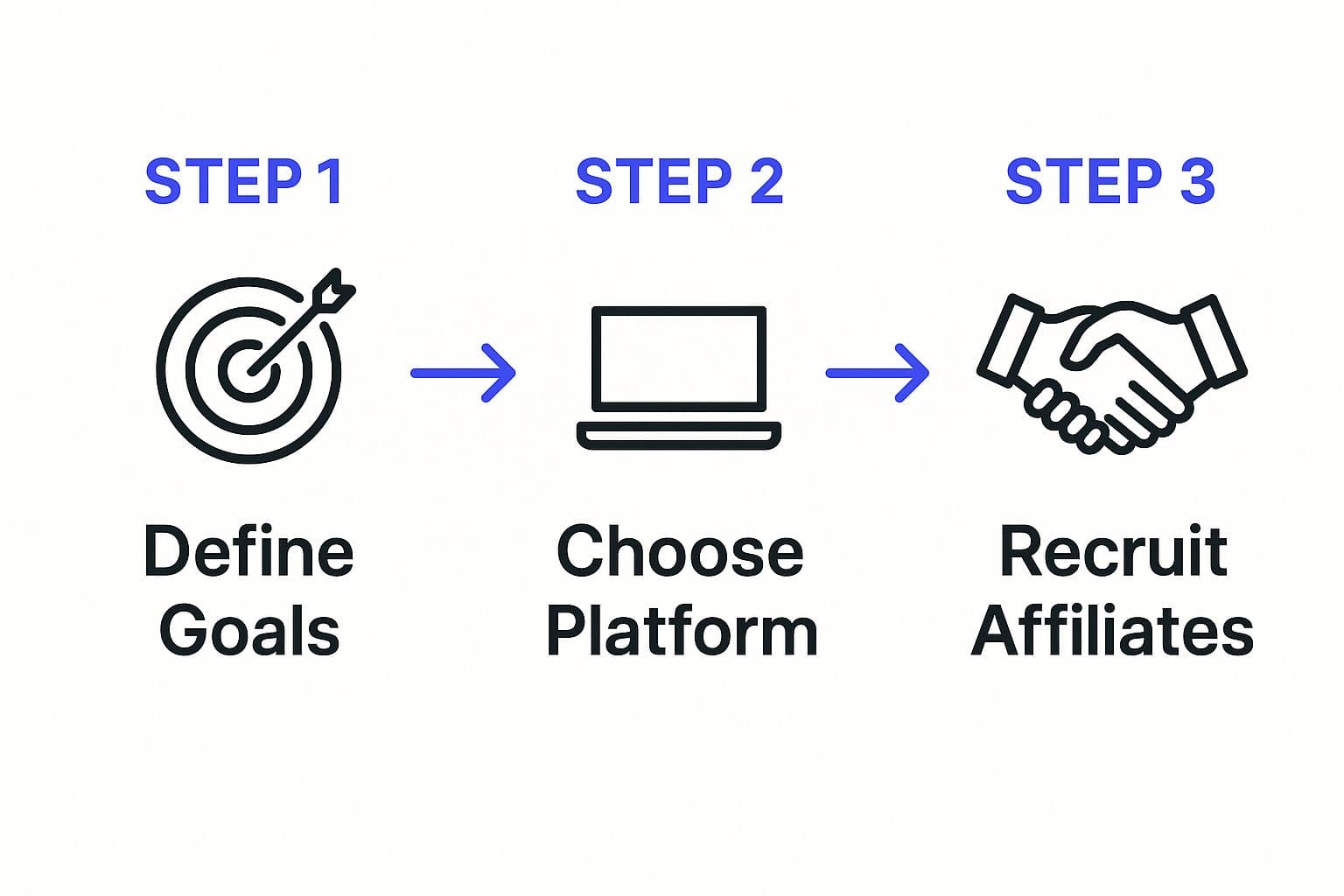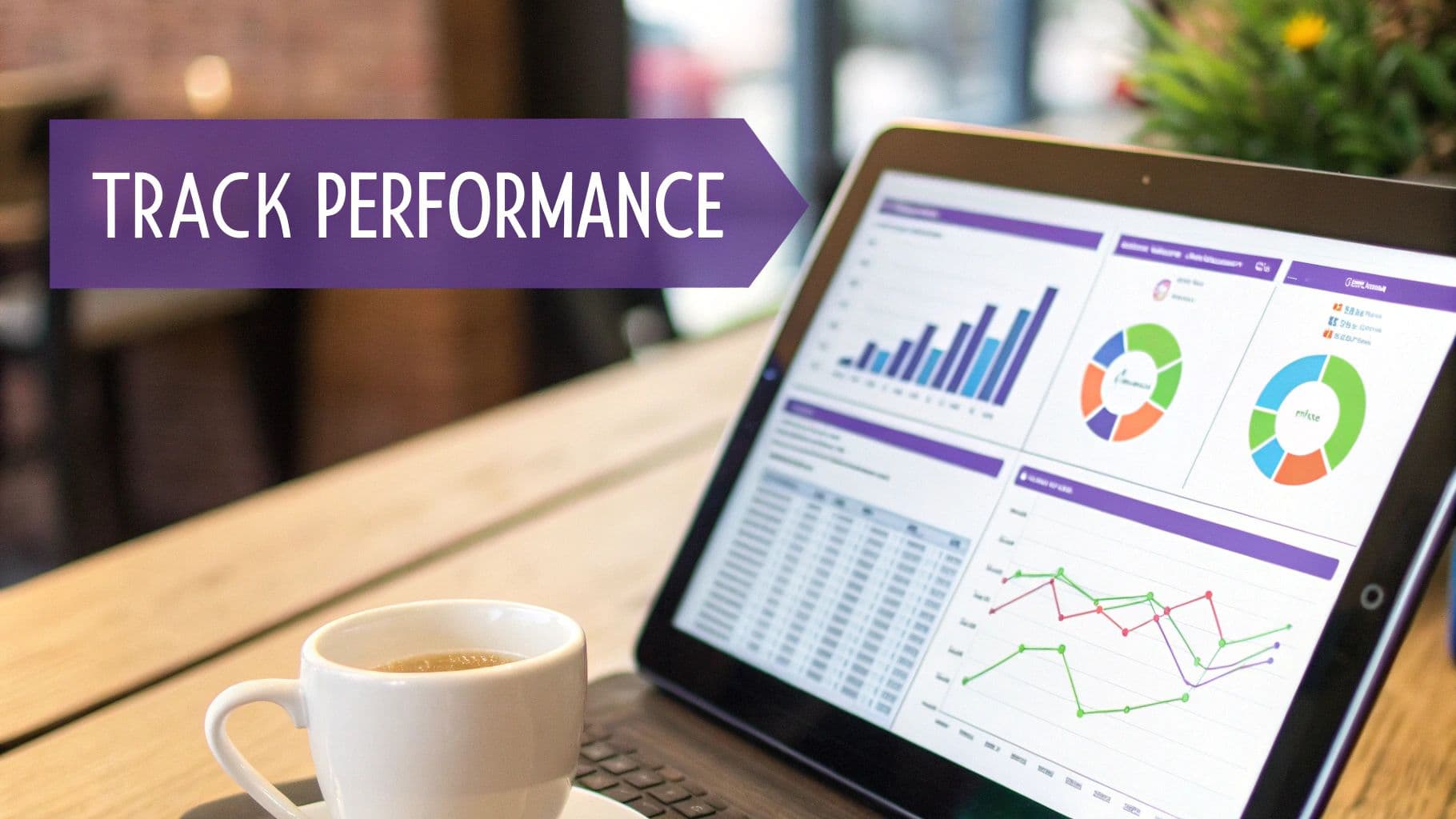How to Start an Affiliate Program That Drives Growth

Before you touch any software or recruit a single affiliate, you must get the strategy right. Skipping this foundational step is the number one reason affiliate programs fail. It’s like building a house without a blueprint—it’s destined to collapse.
A successful program isn't just about offering a commission and hoping for the best. It's a calculated, performance-based sales channel. To build it, you need a solid, actionable plan.
What's the Point? Define Your Primary Goal
First, decide what you are actually trying to achieve. While "more sales" is the obvious answer, it’s too vague. Get specific, because your primary goal shapes every other decision.
Here are actionable goals that define a program's structure:
- Driving direct sales: This is the classic model. Your primary action is to increase revenue directly from affiliate-driven purchases. Your key metric will be sales volume.
- Generating qualified leads: For B2B or high-ticket services, the goal is to get your sales team qualified leads. Affiliates are paid per lead (CPL), not per sale.
- Boosting brand awareness: The goal here is exposure. You might partner with high-traffic bloggers or influencers for sponsored content, paying a flat fee instead of a commission on sales.
Your objective directly dictates who you partner with and how you compensate them. For a sales-focused program, use percentage-based commissions. For a brand awareness campaign, a flat fee for a sponsored post is more appropriate.
Do the Math: Figure Out Your Financial Guardrails
An unprofitable affiliate program is just an expensive hobby. The most critical number to define is your Customer Acquisition Cost (CAC). In plain terms: how much can you afford to pay to get one new customer?
If you don't know this, stop. You cannot set a commission rate intelligently. To calculate your CAC, divide your total sales and marketing costs over a specific period by the number of new customers acquired in that same period. This gives you a hard ceiling for what you can afford to pay out.
Actionable Tip: Don't just copy a competitor's commission rate. Their margins are not your margins. Build your commission structure based on your financial data. What's profitable for them could bankrupt you.
Once you have your CAC, you can design a commission model that is both generous enough to attract great partners and sustainable for your business. For a deeper look at the financial side, our complete guide on https://www.pushlapgrowth.com/blog/building-an-affiliate-program is a great resource.
Why You? Craft Your Unique Value Proposition
Thousands of affiliate programs are competing for the attention of top partners. You must have a compelling answer to the question they will all ask: "Why should I promote you?" This is your unique value proposition (UVP), and it’s what makes top-tier affiliates choose you over a competitor.
To build your UVP, start by auditing your direct competitors. Go beyond their commission rates and analyze these key factors:
- Cookie Duration: How long does an affiliate get credit for a sale after a click? Action: Offer a 90-day cookie window if competitors only offer 24-hours or 30-days.
- Creative Assets: Do they provide polished banners, pre-written email copy, and high-quality product photos? Action: Create a comprehensive asset library to make promotion effortless for your partners.
- Payout Speed: How quickly do affiliates get paid? Action: Offer 15-day payouts instead of the standard Net-30 to create a powerful cash flow incentive.
Your goal isn't to copy them; it's to find their weaknesses and make them your strengths. Perhaps everyone offers a low commission, but your margins can support a higher one. Maybe they all have terrible affiliate support. Your UVP is the specific mix of benefits that makes your program the obvious choice for the best promoters in your niche.
This flow chart gives a bird's-eye view of how these foundational pieces fit together before you ever get to the technical setup or recruitment phase.

As you can see, a clear strategy is the bedrock. Get this right, and you’re setting yourself up for success in an industry that’s only getting bigger.
With affiliate marketing projected to become a $31.7 billion industry by 2031 and over 80% of advertisers already running programs, there's massive potential. But you have to be strategic. For a related perspective that can sharpen your partnership approach, check out this guide on Influencer Marketing 101: How to Start and Best Practices.
Choosing Your Affiliate Management Technology
The tech you pick is the backbone of your affiliate program. It’s the central hub for tracking clicks, attributing sales, and paying your partners. A clunky or unreliable system creates a nightmare for you and a frustrating experience for affiliates, which is the fastest way to kill a program.
Your first major decision is whether to join an established affiliate network or use dedicated affiliate software to run your program in-house. These are two different paths, and the right one depends on your business model, budget, and long-term goals.
The Affiliate Network Route
Think of affiliate networks like ShareASale or CJ Affiliate as massive, pre-built marketplaces. They connect merchants with thousands of affiliates who are actively looking for products to promote. You plug into a ready-made ecosystem.
This gives you instant exposure to a huge pool of potential partners, which can fast-track your initial recruitment efforts.
But this convenience comes with trade-offs:
- The Costs Add Up: Networks typically charge setup fees, monthly minimums, and an "override" fee—a percentage on top of the commissions you pay.
- You're One of Many: Your program is just another listing next to your direct competitors, making it hard to stand out.
- Relationships at a Distance: Communication is often funneled through the network's system, making it harder to build direct relationships with top performers.
This route is often a good fit for e-commerce brands with physical products that need to cast a wide net quickly without a large upfront technical investment.
The Dedicated Software Route
Dedicated software platforms like PartnerStack or Impact.com provide the tools to build and run your own in-house affiliate program. You're not just joining a marketplace; you're building a private, branded ecosystem.
This path gives you total control. You customize everything, build direct relationships with your affiliates, and own all of your data.
Actionable Insight: With dedicated software, you're not just another name in a directory. You're building a proprietary marketing channel that becomes a tangible asset for your business.
The main challenge? You are responsible for recruiting every single affiliate. There's no built-in database of partners, so a solid recruitment plan is essential from day one. This approach is ideal for SaaS and digital product companies that value deep partner integrations and direct, collaborative relationships.
How to Make the Right Call
This isn't about which option is "better," but which is the right fit for your business. Use this table to compare.
| Factor | Affiliate Network | Dedicated Software |
|---|---|---|
| Recruitment | Instant access to a large, existing affiliate pool. | You must build your affiliate base from scratch. |
| Cost Structure | Setup fees, monthly fees, and commission overrides. | Typically a flat monthly or annual subscription fee. |
| Brand Control | Limited; your program is listed alongside competitors. | Full control; you create a branded affiliate portal. |
| Relationships | Often indirect, managed through the platform. | Direct communication and relationship building. |
| Data Ownership | Data is often owned or co-owned by the network. | You own all your affiliate and performance data. |
To make your decision, ask these three questions:
- What’s my actual budget? Network costs can fluctuate with performance. Software is typically a predictable subscription fee.
- Do I have the resources for recruitment? If you have a strong brand or an existing audience, software is a great choice. If you're starting from zero, a network provides an initial boost.
- How important is brand control? If you need a seamless, fully branded portal that feels like an extension of your company, dedicated software is the only way to achieve it.
Nailing this decision is a foundational step in learning how to start an affiliate program that succeeds. Before signing any contract, get demos. Ask direct questions about their tracking methods and review every line item in their fee structure. This choice will define your program's trajectory.
Designing a Program Affiliates Want to Join

You've selected your platform. Now, it's time to build a program that top-tier affiliates actively want to join. This is where your strategy becomes reality.
A great commission rate is just the starting point. Experienced affiliates look for a professional, transparent, and supportive partnership that makes it easy for them to succeed. Your first impression starts the moment they see your program page. That page is not just a sign-up form; it's a sales pitch for your partnership.
Create a High-Converting Affiliate Landing Page
Treat your affiliate landing page like the front door to your program. If it's sloppy or vague, quality affiliates will assume your program is an afterthought and leave.
This page must be polished, persuasive, and answer their key questions instantly. Here are the essential elements to include:
- Commission Structure: Be explicit. Is it a percentage of sale, a flat fee, or a tiered model? State it clearly to build immediate trust.
- Cookie Duration: Clearly state the cookie life, whether it's 30, 60, or 90 days. A longer window is a major selling point.
- Brand Value Proposition: Give them a few compelling sentences on what makes your product a great fit for their audience.
- Payment Details: Specify your payout schedule (e.g., Net-30) and methods (e.g., PayPal, direct deposit).
Finally, make the call-to-action impossible to miss. Use a large, bold "Apply Now" or "Become a Partner" button that guides them directly to the application.
Actionable Tip: Frame your affiliate landing page as an invitation to a valuable partnership, not a legal form. Every element should be designed to build excitement and confidence in your program.
Draft a Fair and Clear Affiliate Agreement
While the landing page is the handshake, the affiliate agreement is the rulebook. This legal document protects both you and your partners by setting clear rules from the start. It doesn't need to be filled with intimidating legalese, but it must be comprehensive.
A solid agreement prevents future confusion and provides a framework for handling any issues.
These are the non-negotiable clauses to include:
- Commission & Payout Terms: Define exactly what constitutes a "qualified" sale. Explicitly list actions that void a commission, such as self-referrals or fraudulent activity.
- Promotion Guidelines: Set clear boundaries. Specify what is and isn't allowed for paid search ads (e.g., no bidding on your brand name), email marketing, and brand asset usage.
- Termination Clause: Outline the conditions under which either party can end the partnership. This protects you from bad actors and gives legitimate partners a clear exit path.
- Confidentiality: If partners will be exposed to any non-public information, include a simple confidentiality clause to protect your business.
A transparent and fair agreement signals that you are a serious, trustworthy partner—exactly what the best affiliates are looking for.
Equip Your Partners with a Powerful Creative Library
The best way to get a new affiliate promoting quickly is to give them everything they need the moment they are approved. A well-stocked creative library removes friction and ensures their promotions are professional and on-brand.
This means more than just uploading a logo. A useful library is a complete toolkit for different channels. Your job is to make promoting your brand as easy as possible.
Here’s a checklist for your creative library:
- Banners & Graphics: Provide a full suite of web banners in standard sizes, plus graphics optimized for social media feeds, stories, and newsletters.
- Swipe Copy: Offer pre-written email templates, social media posts, and product descriptions. This saves affiliates time and keeps messaging consistent.
- Product Photos & Videos: Include high-resolution lifestyle shots, product images, and short demo videos to help them create more engaging content.
Investing in these resources upfront shows partners you're truly invested in their success and separates a good program from a great one.
Finding and Welcoming High-Impact Partners
You’ve built the program's engine with the right tech. Now you need skilled drivers. The long-term success of your affiliate program depends entirely on the quality of your partners. Finding promoters who genuinely align with your brand is your most critical task.
The timing is perfect. In 2023, U.S. affiliate marketing spend reached $9.56 billion, a nearly 14% jump from the previous year, and is projected to hit almost $12 billion by 2025. You can dive deeper into the industry's financial trends with these stats from Wix.
This means there's a huge, growing pool of talented partners available. You just need a smart, actionable plan to find and recruit them.
Where to Find Your Ideal Affiliate Partners
Opening the floodgates to anyone who wants to sign up is a recipe for low engagement and fraud. Instead, be surgical. A proactive, multi-channel recruitment strategy will always outperform a passive approach.
Focus your energy on these high-potential pools:
- Your Own Customers: Your most authentic promoters are people who already use and love your product. Action: Send a targeted email to your most loyal customers inviting them to become founding members of your affiliate program.
- Niche Content Creators: Use tools like SparkToro or a simple Google search for "best [your niche] blogs" to find bloggers, YouTubers, and podcasters who already serve your target audience.
- Competitor Research: Identify who is promoting your competitors. These affiliates have already proven they can sell a similar product to the right audience. You can introduce your program as a compelling alternative.
This focused outreach ensures you’re talking to people with the highest likelihood of becoming top performers. For a deeper dive, read our guide on how to recruit affiliates effectively.
Crafting Outreach That Actually Gets a Reply
Top affiliates are bombarded with generic program invites. A copy-and-paste email will be deleted instantly.
To cut through the noise, show you've done your homework. Personalize your outreach to feel like a genuine partnership offer. Reference a specific blog post or video of theirs that you liked. Clearly explain why your product is a perfect match for their audience. State your commission rate and cookie duration upfront.
Pro Tip: Never start an email with "Dear Partner." Use their first name and mention their website by name. This simple act of personalization shows you see them as an individual, not a name on a list, and will dramatically increase your response rate.
Onboarding Affiliates for a Strong Start
Getting an affiliate to sign up is just the first step. A clunky onboarding experience can kill a new partner's motivation before they generate a single click.
Your goal is to make them feel supported and equipped from day one. A smooth, structured onboarding flow empowers them to start promoting immediately.
Implement this simple, effective onboarding sequence:
- The Instant Welcome: As soon as an affiliate is approved, send an automated welcome email with their unique affiliate link, a login to their dashboard, and a link to a quick-start guide.
- The All-in-One Welcome Kit: Create a central resource hub (a simple Notion or Google Doc works well) with brand guidelines, logos, pre-written social copy, banners, and product images.
- The Personal Touch: A few days after they join, have your affiliate manager send a personal follow-up email. Offer to answer questions or hop on a quick call to brainstorm content ideas. This gesture makes a massive difference.
This level of hands-on support demonstrates your investment in their success and turns a simple affiliate into a powerful brand advocate.
Managing Your Program for Sustainable Growth

Launching your affiliate program is just the starting line. The work that separates a thriving revenue channel from a stagnant one happens in the day-to-day management and continuous optimization.
This is where you shift from builder to grower. Long-term success requires nurturing a dynamic community through consistent engagement and data analysis.
The market context is also crucial. The North American affiliate marketing sector was valued at $7.4 billion in 2024, up from $2.7 billion in 2021, with steady growth projected through 2031. For a closer look, you can explore the full regional analysis on cognitivemarketresearch.com.
Fostering an Engaged Affiliate Community
Silent partners are rarely profitable partners. If affiliates feel disconnected, they won't promote you effectively. Build that connection with regular, valuable communication.
Create a communication plan to keep partners informed and motivated:
- Monthly Newsletters: Share updates on new products, highlight upcoming promotions, and feature a successful affiliate's story to keep your brand top-of-mind.
- Performance Updates: Send personalized emails congratulating an affiliate on a great month or offering tailored tips based on their performance. It shows you're paying attention.
- Asset Refreshes: Announce when you've added new banners, email swipe copy, or video content to the creative library. Fresh assets make their job easier.
This consistent outreach transforms a transactional setup into a genuine partnership. When you show you're invested in their success, they will invest more in yours.
Tracking the Right Performance Metrics
You can't improve what you don't measure. Go beyond sales and commissions by tracking specific Key Performance Indicators (KPIs) to understand what’s working and what isn't.
Actionable Insight: Your affiliate dashboard is a diagnostic tool. The data tells a story about your program's health, partner engagement, and campaign effectiveness. Learning to read that story is what makes a great affiliate manager.
To get a clear picture of your program's health, monitor these core metrics. They provide the actionable insights needed to make smart, data-driven decisions.
Key Affiliate Program Performance Metrics
Use this table to track the essential KPIs that measure the health and effectiveness of your affiliate program.
| Metric (KPI) | What It Measures | Why It's Important |
|---|---|---|
| Active Affiliate Rate | The percentage of your total affiliates who generated at least one click or conversion in a given period. | A low rate signals a disengaged partner base. This metric helps you focus on activation and re-engagement campaigns. |
| Conversion Rate (CR) | The percentage of clicks on affiliate links that result in a sale or desired action. | This KPI reveals the quality of traffic your affiliates are sending. A low CR might indicate a mismatch between their audience and your offer. |
| Earnings Per Click (EPC) | The average revenue generated for every 100 clicks sent by an affiliate. | EPC is a crucial metric for top affiliates. A high EPC makes your program more attractive and helps you identify your most efficient partners. |
By closely monitoring these numbers, you can spot trends, identify top performers, and fix issues before they grow.
Motivating Top Performers and Re-Engaging the Dormant
The 80/20 rule applies: a small group of affiliates will drive the majority of your results. Your management strategy must reflect this reality.
To motivate your top performers, go beyond the standard commission:
- Implement Tiered Commissions: Create a system where affiliates automatically earn a higher commission rate after crossing specific monthly revenue thresholds.
- Offer Performance Bonuses: Run quarterly contests with cash prizes or free products for the top seller or the affiliate with the most new customers.
Simultaneously, address dormant affiliates—those who signed up but have generated no clicks. A simple re-engagement campaign can work wonders. Send a personalized email asking what they need to get started or offering a temporary commission boost to bring them back into the fold. For more advanced strategies, check out our guide on how to increase affiliate sales.
Common Questions About Starting an Affiliate Program

Even with a solid plan, questions are inevitable. Getting clear answers to these common concerns can save you headaches and help you launch with confidence.
Let's tackle the most frequent questions from founders, covering costs, commissions, fraud, and timelines.
How Much Does It Cost to Start an Affiliate Program?
Costs vary widely based on technology and commissions. The biggest decision is joining a network versus using dedicated software.
Large affiliate networks may charge a one-time setup fee of $500 to over $2,000, plus monthly minimums and a network fee (a percentage of every commission you pay). In contrast, SaaS platforms like Post Affiliate Pro or Tapfiliate typically have a straightforward monthly subscription from $100 to $1,000+, depending on your scale.
Remember, your largest ongoing cost will be the commissions you pay to partners. Also, budget for creating marketing assets and potentially hiring an affiliate manager as you grow.
What Is a Good Commission Rate to Offer Affiliates?
There's no single right answer. Your rate depends on your product, profit margins, and industry standards. The goal is to find a rate that attracts quality partners while keeping your customer acquisition cost (CAC) healthy.
Here are some general benchmarks:
- Physical Products: Typically 5% to 30%, due to tighter margins on tangible goods.
- Digital Products & SaaS: Can be much higher, from 20% to 70%, sometimes including recurring commissions on subscriptions.
Actionable Tip: Research what your direct competitors offer. This gives you a competitive baseline. You can then add performance tiers to reward your top affiliates for driving more business.
How Do I Prevent Affiliate Fraud?
Be proactive. Your first line of defense is your platform; choose one with built-in fraud detection tools that can automatically flag suspicious activity.
Next, use your affiliate agreement to explicitly outlaw common scams like cookie stuffing, bidding on your branded keywords, or using misleading ad copy. This document gives you the legal grounds to terminate a fraudulent partnership.
Finally, manually review every affiliate application before approval. Monitor your analytics closely. An unusually high click-through rate with zero conversions is a major red flag for bot traffic.
How Long Does It Take to See Results?
Manage your expectations: an affiliate program is a long-term growth channel, not a magic button for instant sales. You should expect to see meaningful results within 3 to 6 months.
The first couple of months involve setup, recruitment, and onboarding. After that, it takes time for affiliates to create content, build campaigns, and for that content to start driving traffic.
Success requires patience and consistent effort. It's about building momentum over time. You must actively manage the program, engage with partners, and continuously optimize your approach. Like planting a tree, it needs time and care before it bears fruit.
Ready to build and manage a high-performing affiliate program without the complexity? Push Lap Growth provides all the tools you need—from a fully branded portal and automated payouts to fraud protection and a curated affiliate marketplace. Start your 14-day free trial and see how easy it is to accelerate your growth. https://pushlapgrowth.com